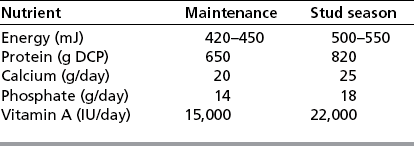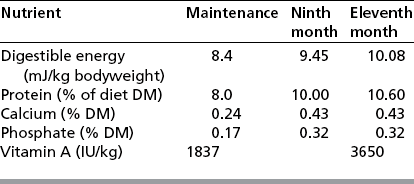Chapter 2 There is little information on the specific needs of breeding stallions, but most resting stallions and those with less reproductive demand (‘small book’) require little more than the normal maintenance requirements for all nutritional components. There is no evidence to suggest a link between stallion fertility and diet, but it is reasonable to suppose that a good healthy diet results in a healthy horse with breeding vigor. A suitable maintenance ration for a 500-kg stallion should provide the amounts shown in Table 2.1. Before the start of the breeding season the stallion should receive a small concentrate feed so that his weight increases slightly. Stallions with a heavy reproductive demand or those in inclement (cold) conditions will inevitably need at least some concentrate feed. Regular accurate weight measurement is probably a very useful management procedure. Working stallions should not be overweight; indeed, there is probably some merit in maintaining a body condition score of 3.5–4.5 (on a scale of 10) during the breeding season. Obesity may result in lowered daily sperm output (see p. 51). Similarly, a stallion that is underweight will probably not be a long-term vigorous breeder. Dietary supplementation with vitamins and minerals does not seem to be helpful in the face of a good, balanced roughage diet based on high-quality hay or pasture. In particular, vitamins A and E do not seem to be needed in extra supply for normal fertility and libido,1,2 but the provision of the extra diet usually results in increases in supply in any case. Moderate daily exercise is probably essential for working stallions, but during this time they are at some risk of self-trauma or escape. Suitable facilities must be provided for safe exercise, either on grass paddocks or in well-protected yards. Access to good pasture should be encouraged to allow free movement and the stimulation of sunshine and grass, but excessive exercise should be avoided.3 Nutritionally, the most important part of gestation is the last 3 months, during which the foal is growing very quickly; up to 60–65% of its birth weight will be gained during this time.4 The extra demand on the mare during early gestation is regarded as insignificant (but not unimportant as mares that lose weight in early lactation have a lower chance of conception). The total weight gain in the full-term mare is around 12% of her bodyweight. Thus, the nutritional demand on the mare is high during the later stages of gestation; the increase in energy demand in the ninth month of gestation is around 10% and this rises to 20% in the eleventh month of gestation (see Table 2.2). In some cases, reliance on forage alone is poor practice because the mare cannot possibly ingest enough food to maintain her own condition and that of the fetus. Furthermore, the appetite/feeding capacity of the mare falls from 1.8% of bodyweight (dry matter terms) to 1.4% at full term.5 Mares do not respond to the flushing system (beginning with a thin mare and providing high nutritional planes) prior to breeding that is used in farm animals.6 Body condition is probably linked to cyclicity of the ovary. Mares in poor body condition appear to have less ovarian activity than control mares at grass.7 A low plane of nutrition and weight loss during prebreeding and breeding periods reduces reproductive efficiency. Thin mares (with body condition score <2.5 on a scale of 10) have reduced ovulation, reduced conception rates and a higher rate of early embryonic loss8,9 (see p. 253). Increasing the energy intake by 50% has no effect on its own on ovulation or cyclicity, but mares with body condition scores of over 3 (on a scale of 10) have increased follicular activity.10 Optimal reproductive efficiency is probably achieved when the body condition score is around 3.5–4 (on a scale of 10). High planes of nutrition (gradual increase in energy intake and weight gain) are probably therefore beneficial to fertility.
FEEDING AND EXERCISE
STALLIONS
Feeding
Exercising
MARES
Feeding
![]()
Stay updated, free articles. Join our Telegram channel

Full access? Get Clinical Tree


FEEDING AND EXERCISE


